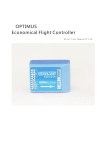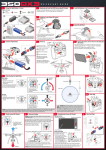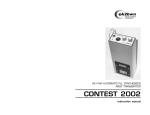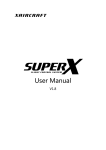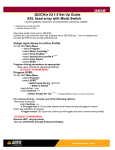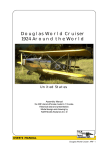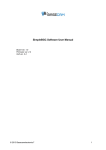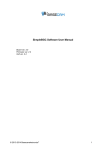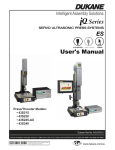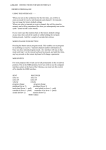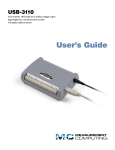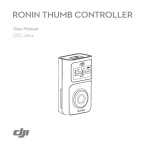Download User Manual for Optimus Flight Controller
Transcript
OPTIMUS Economical Flight Controller Brief U ser M anual(V1.0) Content -1- Warning & Disclaimer Multi-rotors Flight Controller is an excellent autopilot system. Although we do our best to let the controller in the safest state when there is power input, for example: signal is prohibited sending from the motors to the ESCs, in the process of system calibration and parameters setup, we still strongly recommend customers to remove all propellers, and use UBEC to supply power to the FC and keep children away . We assume no liability for damage(s) or injuries incurred directly or indirectly from the use of this product. -2- Product Profile Multi-rotor flight controller is an autopilot system designed for aircraft model hobbyists, which is mainly used on multi-rotors aircraft. The autopilot system has the attitude stabilization function . It is very popular in amusement, aerial photography and other FPV activities. QUAD-ROTOR Flight Controller Control Modes Atti. Mode Manual Mode Maximum rudder angular velocity is 180°/s Command Stick Meaning Multi attitude control; Stick center position for 0˚ attitude, Stick endpoint is 35˚attitude. No height lock. YES Command Linearity Stick Released Safety Maneuverability Maximum pitch and roll angular velocity is 220°/s, No height lock. No position holding, only attitude stabilization NOT Recommend Low voltage protection Depends on experience. High agility, high stability High agility Items in the Box Main Controller (MC) ×1 The Main Controller (MC) is the brain of the system. Through it, ESCs are connected to the RC receiver and other equipments to achieve autopilot function. It has a built-in Inertial Measurement Unit (IMU) containing one 3-axis accelerometer, one 3-axis gyro. Versatile Unit (VU) ×1 It includes a LED light which indicates different states of the aircraft and a USB port for configuration. USB Cable ×1 This cable is used to configure MC. 3-PIN Servo Cable ×7 Cables are used to connect the MC and the receiver 3M Gummed Paper ×6 It is used to fix MC and VU module -3- Notice 1.Please disconnect ESCs with battery or remove all propellers during the configuration ! 2. Don’t put the MC upside-down. The output ports of MC(Direction of the arrow) should point to the front of multi-rotor. 3. You have to restart the MC and calibrate the Tx again when you change the RC system. 4. In the process of Tx Calibration : Throttle: Slide left is craft down, slide right is craft up; Rudder: Slide left is nose left, slide right is nose right; Elevator: Slide left is craft back, slide right is craft front; Aileron: Slide left is craft left, slide right is craft right. 5.Before flying, make sure switch on the transmitter firstly, then power on multi-rotor. After landing, power off multi-rotor firstly, and then switch off the transmitter! 6.If you turn on the gimbals control during the configuration, there will be output from X1 and X2 ports. Now you should not connect these ports to ESC which is equipped with propellers and motors. 7.During the flight, throttle stick position should be always higher than 10% t ravel . 8.Low voltage protection is NOT for fun! You should land your multi-rotor ASAP in any case in order to avoid crash and other damages. 9.By using Immediately mode to stop motors, in any control mode, motors will stop immediately when throttle stick is under 10% . In this case, if you push the throttle stick over 10% in 5 seconds after motors stop, motors will re-start; Combination Stick Command (CSC) is not needed to restart notors. If you don’t push throttle stick over 10% after motors start in 5 seconds, motors will stop automatically. 10.Red light blinking indicates battery voltage is low, please land ASAP. 11.Do NOT move any command sticks and the aircraft during system initialization and selfcheck! -4- Assembly Mc please use 3M gummed paper provided to mount MC. The output ports of MC(Direction of the arrow) should point to the front of multirotor. You’d better put MC at the gravity center of multi-rotor. Please make sure all ports are accessible when installing the MC so as to facilitate connecting wires and software configuration. in 3-pin ports. pins near the nicks are signal pins. After choosing a location to mount the MC, it is recommend that you Do NOT mount the MC until all wires are connected and software configurations are completed. FUTABA/HITIC RECEIVER 1 2 3 4 To ESC motor 7 AUX2 JR RECEIVER RUDD M5、M6 or to Gimbal ELEV AILE THRO To Battery R/C system These are example connections. Please setup Airleron,Elevator,Throttle,Rudder channels on Tx first, and choose one 2 positions switch / channel as control mode switch, then connect your receiver to the right ports on MC. LED 2S-4S VU Do not mount it on any other electronic devices. Make sure you can see the LED light during flying. LED indicator is 4-pin wire,E5 port is 3-pin wire. Assistant Software Installation In order to make it easier for users to install the configuration software and simplify the operation, we made the installation package, just copy the files in the CD into the computer, then click the file installation and implement it. Compatible computer’s system: XP, Win 7(32 bit). If you Win7( 64 bit) system, please press “F8" function key when you start the system,then will pop up a start list, select”do not start using number certificated sign”, then the software can work normally. -5- MOTOR STARTUP: In case of false operation of the throttle sticks, please start the aircraft by using the two unlock way. Move the sticks as shown on the image, execute any one way will start motors. After executing this procedure, You have to push the throttle stick in five seconds , otherwise the motors will stop running and you have to repeat the procedure. After the motor stop running , if you directly push the throttle stick in five seconds ,motor will work again and unlocking operation is not needed to execute . Do not execute these unlock procedure during flying in case of causing false operation. Trim compensation: Each flight controller is calibrated and tested before sending out. But sometimes there may be an error during the aircraft mechanical components installation or the FC is not in an absolute horizontal position when installed , and this can cause the airplane a small drift during flying .So Drift compensation function is opened for this case and it the drift phenomenon can be modified within a certain range. Operation method (when there is a drift phenomenon during flying): Land the aircraft , keep the throttle stick at the lowest position more than 5 seconds (throttle control is in the locked state, the motor will not work if you push the throttle stick at this time). Push the throttle stick to the highest point then enter into the calibration mode as shown in figure 2. 2.At this time, the stick which control the aircraft's front and back, right and left is used as “functional” sticks. If the aircraft is drifting to front during flying, move the elevator stick back to the stick’s biggest travel( each push is a unit volume for modification, if modification is not enough, push a few times). If the aircraft is drifting to back then push the elevator stick front to modify. The modification for the aircraft’s right and left drift is the same reason. If the aircraft is drifting to left during flying, move the aileron stick right to the stick’s biggest travel( each push is a unit volume for modification, if modification is not enough, push a few times). If the aircraft is drifting to right then push the aileron stick left to modify. Finally, push the “functional “ stick in the center position and also make the throttle stick return to the lowest point. 3. Unlock the transmitter , start the motors and test whether the drift is improved or not . If not , please repeat step 1 ,2 procedure above. ELEV(俯仰) THRO(油门) RUDD (方向舵) RUDD (方向舵) AILE (横滚) THRO(油门) THRO(油门) AILE (横滚) ELEV(俯仰) Picture1 Picture2 -6- SOFTWARE PROCESS Introduction of the function buttons of the main interface Meaning of the red marked numbers above: 1. It means to import the flight control parameters saved last time from the file, including the calibration parameter of the radio. If the radio is not replaced and neutral position has not changed, there is no need to calibrate again. Parameters will be input and written into the flight controller 2 . Output parameters: Save all the parameters of the current flight controller to a file in order to be convenient to write into the flight controller next time. 3. Read the current flight controller parameters. It can be used only when flight controller is successfully connected. 4. Write the changed parameters into flight controller. It can be used only when flight controller is successfully connected. 5. It is the parameter setting interface of current selected function. 6. Display interface of the flight controller’s current state: .Red light blink : The flight controller is not connected to the computer. .Yellow light blink: Signal transmission. Green light blink: The flight controller is successfully connected. 7.Display area of language choose, minimize button and close button. 8.Function selection area: display or set the parameters as needed. 9.Image display area. 10.Current place of mouse, it is the description of the related functions. -7- Motor Setting 1.Set the aircraft’s type. There is mainly four aircraft’s type, Default is Quad copter X. If choose other types, click the appropriate type button and then click”Write”. (Red number 4 of the interface button) . If you select the hexacopter type, X1 is for M5 and X2 is for M6. Please connect the motor according to the instruction and see the motor’s rotating direction is right or not, if not , switch any of two wire connections of the incorrect motor to change it’s rotation direction. M2 M1 Front M1 M6 M2 Front Front Front M2 M2 M1 M1 M6 M3 M4 M3 M4 M5 M3 M3 M4 M4 M5 2.ESC type select. There are mainly two types of ESC- 500 Hz high speed ESC and 400hz normal speed ESC, click “write” and write it into the flight controller after choosing. It is prohibited to use 500Hz ESC after you choose 400Hz ESC type in Motor Setting procedure. It can cause damages because the motors will spin at a high speed . 3.Idle speed setting: Set the speed of the motor rotation after unlocking. Default is 20% of the throttle whole travel. It can also be changed according to your needs. Highest is 30% of the throttle whole travel. 4.Set the time to stop motors. That is, motors can rotate how long when the throttle stick is at the lowest point. From left to right, the rotating time increases by degrees. On the rightmost side, motor keeps spinning and can only stop by the radio. -8- Tx calibrate 1. Calibration of Tx ,channel data Reverse and Normal, four channels direction principles are as follows: Throttle: Slide left is craft down, slide right is craft up Rudder: Slide left is nose left, slide right is nose right Elevator: Slide left is craft back, slide right is craft front. Aileron: Slide left is craft left, slide right is craft right Tx calibration procedure: Click START button, move the radio’s four channel individually to the highest and lowest point, after do that, the other three channels sliders should be in the middle except T. Confirm the channel data direction according to the show situation, and then click the End button. Then push the throttle stick, see if the slider’s move is following these principles, if not, click the normal button on the right, then the button will be changed as Reversed, push the stick again and see if the direction is same as the above principles. Test each channel like this. 2. Monitor Auxiliary channel E1. 3. Display the flight mode of current flight controller. 4. Set throttle curve parameters and the corresponding curve, write individually numbers in the two texts ( range 0-100 ) Select the needed curve according to the curve shown on the left,After finishing setting, it i s n eeded to click”Write” button to write the data into the controller. -9- Autopilot: 1.Adjustment of flight controller’s gyroscope sensitivity and flexibility. Sensitivity of Roll and pitch can be changed via the auxiliary channel E1, you can also choose “cancel” and use manual input. Input the Yaw gain by hand according to the needs, manual input range(0~255). Flexibility of Roll and pitch can be adjusted via the auxiliary channel E1, you can also choose “cancel” and use manual input, manual input range(0~255). If need to set as default values, click the default button. 2.Trim: The two text display is the current flight controller’s value fine-tuning in the roll and pitch directions. Reason of setting the offset : when flight controller is in attitude mode, there is no input in the throttle’s roll and pitch channel. At this time, the aircraft will be obviously towards one direction, then you can set the aircraft‘s offset in that direction according to the situation of the aircraft .For example: In the case of no input in any radios’ channels exluding the throttle channel, while the plane is toward front , so in order to correct this offset, it needs to add a fine-tuning value. Ensure flight controller is not turned on and push the throttle stick to the highest point , then push the stick controlling the aricraft’s pitch back (opposite to the aircraft’s Offset direction) to the highest point . Monitor this values’ change on the software, ( increase per 1 shows per 0.1 increase). The method of setting the offset in other three drections is the same. Offset adjustment can be currently made in the flying field , and judge the setting value is appropriate or not according to the plane’s real-time state. That’s the Drift compensation as introduced before. 3.PID Setting If you don’t understand the meaning of PID, it is prohibited to change the default parameter. If changed and the effect is not good, please click the PID default button. If you want to change the PID value, it needs to click the PID setting button. .All the changes above need to click the Write button to input the changed content. -10- Voltage Monitor 1.Show the current voltage of the flight controller(For reference only) 2.Set the protecting voltage value, default is for reference. It can be set according to the situation. Notice: The second level protecting voltage should not be set too low, otherwise can be easy to cause crash . -11- PTZ Control 1.Button of PTZ control: default is “ turn off”. When turn on the button, choose the related frequency of the servo. E1 is for controlling the PIZ’s pitch. The aircraft’s roll will be self-balance based on the flight cotroller’s situation. 2.Set the two servo’s min, mid, max value. 3.Sensitivity of the camera mount: Set the parameter according to the real effect of the gimbals. Revised direction button: choose “Normal" or “Reverse" based on the camera mount's balance state. All the changes above need to click the Write button to input the changed content. Notice: X1,X2 is the port for gimble control( when the aircraft is quad-rotors). If it’s hexacopter, there will be no gimble control function and X1 is for M5, and X2 is for M6. -12- APPENDIX 1 Port Description Main Controller For roll control(left/right) For pitch contro(front/back) For throttle control For rudder control For control mode switch For gimbalcontrol Main Controller Not available Not available Not available For monitoring voltage(connecting the Versatile Unit) To # 1 motor To # 2 motor To # 3 motor To # 4 motor To # 5 motor/gimbal pitch control To # 6 motor/gimbal roll control LED port,for LED wire connection from Versatile Unit Expansion port ,for future upgrade and usage Versatile Unit V-SEN V-sen port:to MC E5 port,for monitoring battery voltage。 LED LED wire,to MC LED port Micro-USBport:PC connection for configuration and firmware upgrades. -13- APPENDIX 2 LED Description: Self-check Self- check finish LED blinking indifications LONG Green light blinking Atti.Mode Green light blinking Manual Mode Red light blinks slowly, First level voltage protection warm Red light blinks quickly, second level voltage protection warm Long red light blinking. Show Error Reasons of the Error: 1. The transmitter’s signal is not detected, please check the transmitter’s switch is on or off ,also check the frequency of the trasmitter and receiver to make sure it is same . All wires connection needs to be checked as well. 2.Tx calibration is false and please calibrate it again. -14- APPENDIX3 Specifications Built-in Function 1. Attitude mode and manul mode Autopilot 2. Low voltage Protection Peripheral Supported Multi-rotors: Supported ESC Output: Transmitter requirement: quadcopter , hexacopter 400Hz normal ESC and 500Hz high speed ESC PCM or2.4GHz with minimum 4 channels Assistant Software System Requirement:windows XP , Windows7 Electrical and Mechanical Working Voltage Range: 1 .MC:4 .8 ~5 .5V 2. VU:7.2V~14.8V(2S~4S LiPo) Power Consumption:1.25W,(0.25A/5V) Operating temperature:-10℃ ~ 50℃ Weight: MC:25.5g,VU:9g Dimension:MC 43mm×36.5mm×18mm -15-
















